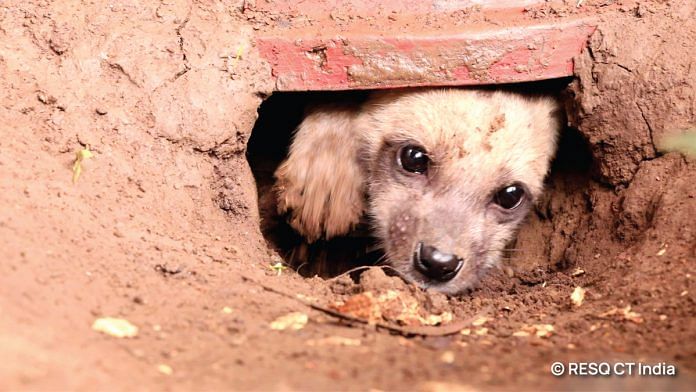In March 2021, a hyena cub was found was found in Nashik very close to a human settlement area by the Nashik Forest Department and Eco-Echo Foundation, an NGO. Attempts to reunite it with its mother had failed, leaving the orphan with two potential outcomes. One, get sent to a zoo and remain captive for life, or two, perish as an infant like most orphaned wild animals who cannot survive the wild independently.
With no zoos ready to take her in at that point, members of the Eco-Echo Foundation reached out to my organisation, RESQ Charitable Trust. They wanted to see if our Wildlife Centre in Pune would admit an orphaned hyena cub and raise her with the aim of giving her a second chance at life in the wild. We had rescued and rehabilitated a Rusty Spotted Cat and several other mammals and birds in the past – but a hyena would be the first. Besides it being a mammoth task to meticulously raise, rehabilitate and reintroduce an orphaned cub to the wild, I wondered about the value this entire process would hold in the grander scheme of things.
The rationale
The International Union for Conservation of Nature (IUCN) has categorised the Striped Hyena as ‘Near Threatened’. This is because the population of this species was assessed to be below 10,000 globally. This species has faced persecution through the ages. Many say their population has taken a severe beating due to habitat destruction and retaliatory killings owed to popular beliefs. In mythology and folklore, hyenas are symbols of treachery and stupidity. Stories of them preying on children have led to them being generically unpopular and greatly misunderstood, and it is not uncommon to hear about them being poisoned or captured for preying on livestock. A grossly false assumption is that they are menacing – in actuality, Indian Striped Hyenas are quite shy and elusive.
However, this begs the question: Can captive wildlife ever be released in the wild? Katie Moore, Deputy vice-president of the conservation and animal welfare NGO, International Fund for Animal Welfare states, “For the longest time, the idea of returning animals such as large mammals to the wild was just off the table, but now we’re seeing people in the field questioning the long-held belief that it’s impossible to return captive animals to their natural habitat. In a lot of cases it is still impossible, especially if the animals have been traumatised when young or raised in poor captive conditions. One also needs to be very careful about introducing diseases to a wild population. But if we proceed scientifically and thoughtfully, it can be done.” The African Lion and Environmental Research Trust (ALERT) has reintroduced captive raised lions for years and they state that while lions can become habituated to humans, they make sure the ones they release are not.
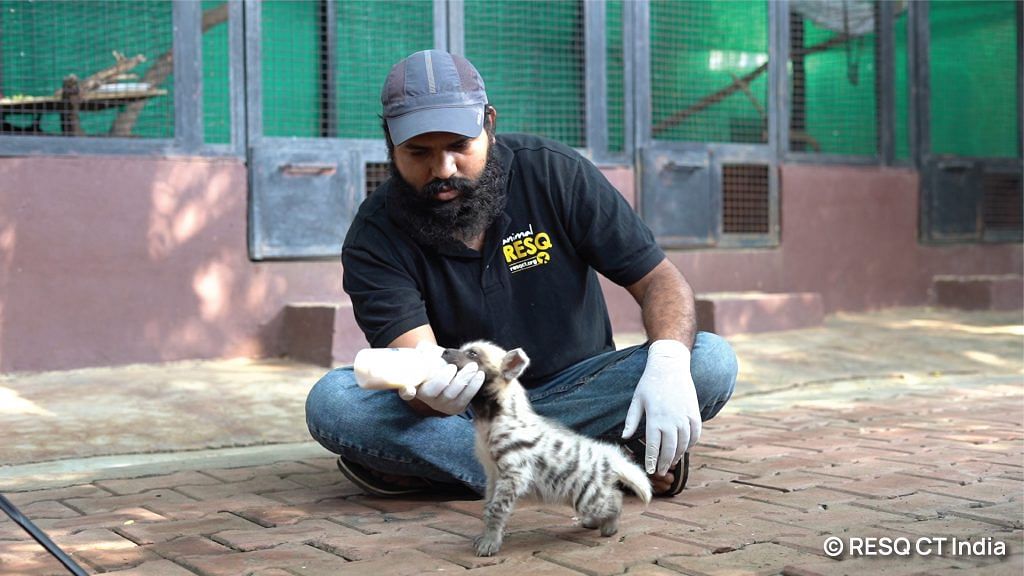
I thought to myself, “What options does this hyena have left? Why subject an animal to a lifetime of captivity if we can teach her to survive the wild?” If successful, she could be the torch bearer for several others who get sentenced to a lifetime of captivity without being given a chance. Zoos and rescue centres have limited capacity and while they serve their own purpose, it is possibly wiser for them to reserve space for problem or conflict animals that have no other choice than to be sent to captivity for the safety of both, animals and humans. We decided we’d take her in and give her the best possible chance for a future in the wild.
The Nashik Forest Department brought her to RESQ, Pune, and we decided to embark on the journey of her possibly becoming the first Indian Striped Hyaena orphan to be raised, rehabilitated, GPS collared and reintroduced to the wild.
Also Read: These rescuers are saving humans and snakes from each other
The rehabilitation process
We knew our goal from day one, we had to keep her wild in order for her to have any chance of future survival in a natural habitat.
Befuddled between the dog and cat family, the Indian Striped Hyena is from the Hyaenidae family and is characterised by its iconic vertical stripes and pointy ears. Behaviourally, it is nocturnal and usually spends most of its day hiding out in its den. They can either be solitary or found in small groups of one or two. They use their ‘hyena butter’, an anal secretion that allows hyenas to mark their territories by ‘pasting’ stones, tree trunks, grass and stalks. They are scavengers by nature and their guts have a high level of hydrochloric acid that allows them to digest rotting carcasses and pulverise deadly microscopic bacteria safely.
As cubs, hyenas need some level of interaction and company to thrive and get past separation anxiety. Since we had no other hyena cubs, one dedicated handler was assigned to help her cope in her early days. When left alone in the nursery, she was closely monitored through live cameras day and night. An exhaustive list of rehabilitation milestones was drawn up. She had to tick off every single one in the next few months to even be considered for release in the future.
As soon as she started self-feeding, which was 21 days from the time she arrived, we began the process of desensitising her to all human contact. We needed her to learn to ‘not’ trust people, a key trait for survival in the wild.
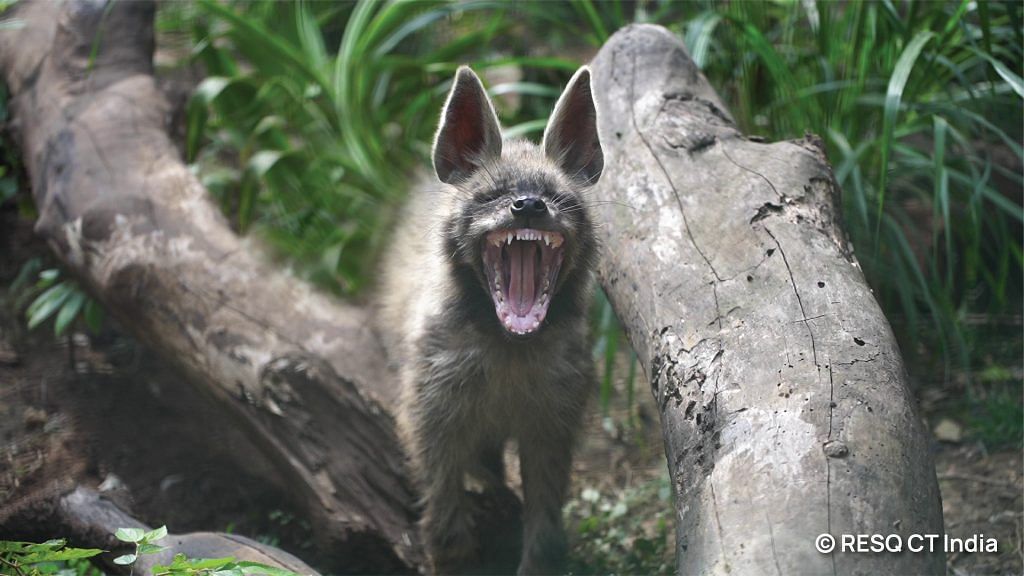
As she grew bigger, she moved enclosures. These enclosures differed in size and enrichment, thus providing the juvenile hyena with opportunities to cultivate her wild instincts. She displayed pasting behaviour, would mark her territory every time she was moved and dig herself a den to safely snooze during the day. Exposed to varying qualities and frequencies of food and water, she was subjected to scarcities and different weather conditions over the year. We often discovered that she would hide parts of her meals and go back to it days later.
In about a year, she had grown from 400 grams to 20 kilograms. We monitored her hormone levels at different stages to assess maturity and realised it would be soon time to prepare her for release.
Also Read: 85 protected turtles from Maharashtra have reached UP to lead a free life
Identifying a suitable habitat for reintroduction
The reality we live in is that even if an animal is physically capable of reintroduction to the wild, finding suitable release sites is extremely challenging.
When we were actively looking for suitable habitats to plan a release, Range Forest Officer Nivruti Chavan of Satara Forest Department visited the RESQ Wildlife Centre and got a glimpse of the hyena. He was amazed to see how she ran off into her self-made den when he walked near her ex-situ enclosure. Amit Sayyed, Wildlife Researcher and Founder of the Wild Life Protection and Research Society (WLPRS), directed us to an area that was rich in wildlife and sufficiently distant from human settlements present in RFO Chavan’s range. He told us that it was a safe and ideal habitat to release and monitor her if we could secure official permissions.
Madhav Mohite (IFS), Deputy Conservator of Forests, Satara visited the RESQ Centre shortly after, where we requested him to consider releasing this female hyena in his forest division. He wanted to see her for himself. When we took him near her enclosure, she put on her best behaviour – she darted away straight into hiding at our approach within seconds and all he got was a fleeting glimpse of her!
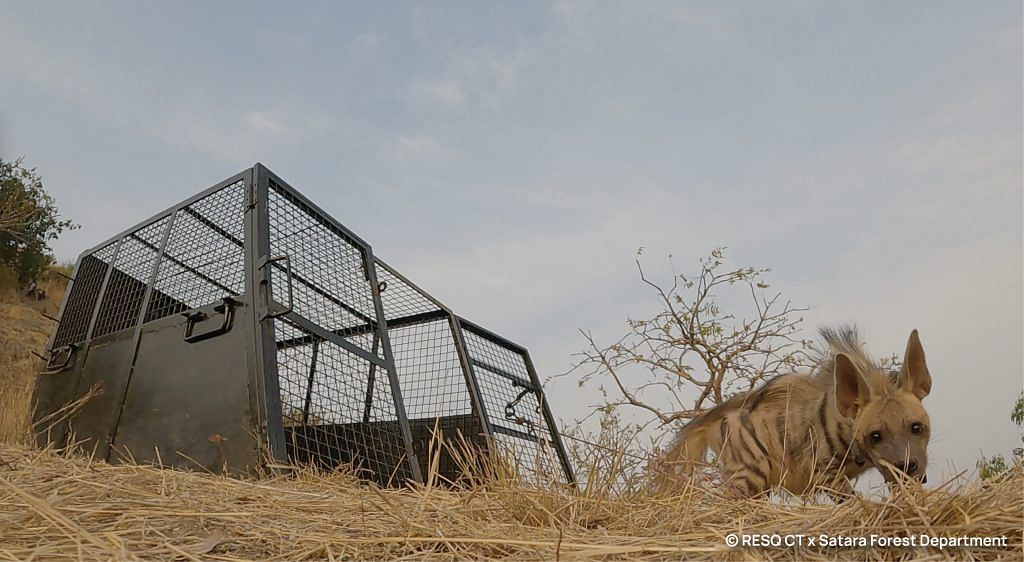
“The hyena did not even come out for the people who had raised her from infancy. She appeared healthy, active, alert and wild. We have a lot of areas in our division where wildlife thrives without being in conflict with humans. The RESQ team had already put in a lot of effort into rehabilitating this hyena and were willing to GPS collar it for monitoring purposes. Our local forest department team was enthusiastic about taking the initiative and we were happy to provide any support needed to secure this hyena’s future. Once the team indicated that she would be ready for release at 12-14 months of age, I sought permission for her release from the Principal Chief Conservator of Forests (Wildlife), Maharashtra” said Mohite.
Dr José Vicente López-Bao, CSIC Senior Research Scientist from Biodiversity Research Institute (IMIB) Spain sent a GPS tracking collar to help RESQ monitor her movements closely. Before releasing her, we conducted a complete medical health check-up and put on the collar to acclimatise her to it. Based on previous measurements we had taken of a large-sized adult female hyena, we padded up the collar and kept it loose (but irremovable) considering any increase in neck girth with age.
Also Read: Why Parliamentary panel for environment wants a new mechanism to manage human-animal conflict
Back to the wild
Then, the D-day arrived. Members from RESQ and the Satara forest department surveyed the area in advance and set up camera traps. A strategic release location was determined keeping in mind adequate prey and water supply. This location also allowed us to monitor the hyena while keeping safe distance.
As she took her first steps towards freedom, anxiety hit us. Would she manage the terrain? Would she survive for even a day? The entire team felt like parents watching a child move away from the safety of their home. You know you have to let go, but it’s the hardest thing you’ll ever do. As soon as she got out, she squatted, pasted and marked territory as if signifying her arrival. She headed for a densely vegetated patch nearby and quickly disappeared out of sight.
Also Read: Odisha: Bhubaneswar-based NGO providing shelter to animals amid soaring temperatures
Alive and kicking!
Today is day 14. She’s made it for the last two weeks. Initially, she remained in 600m of her release location. But as day 2 hit, she began exploring. Our teams stayed in the area and continued to monitor her shenanigans. Over the next few days, she appeared on our camera traps near a water source multiple times along with several wild animals including jackals, foxes, wild boars and porcupines.
On day 6, the tracking team accidently bumped into her while on foot. She directly looked at them for a few seconds and darted away as though she was worried that they’d capture and put her in an enclosure again. Amit Todkar, a member of the RESQ tracking team, recollects, “It was actually a moment of pride when she ran away from us instantaneously. To us it meant that she was comfortable where she was, free and happy.”
“While reviewing the camera trap footage over the last few weeks, what we see in the videos is a confident female walking by. We are relieved at her progress and quite convinced that she has found food and the means to keep herself safe. Our thermal drone scans show plenty of prey base in the area and we will monitor her actively for a few months more till we are certain she is doing okay. The first two weeks were critical because it is the summer and we want to make sure she has settled in properly before the monsoon arrives,” says Tuhin Satarkar, Field Director, RESQ.
“We are proud to have released India’s first captive raised Striped Hyena in our division,” says DCF Madhav Mohite, “and what is even better is that we know she is thriving really well so far. Our local forest officers and the RESQ team are monitoring her and the area actively. Previously wild orphans would either not survive or just be sent to rescue centres or zoos, it is good that we can now consider another option of reintroducing them back in the wild, at least for some non-conflict wildlife species.”
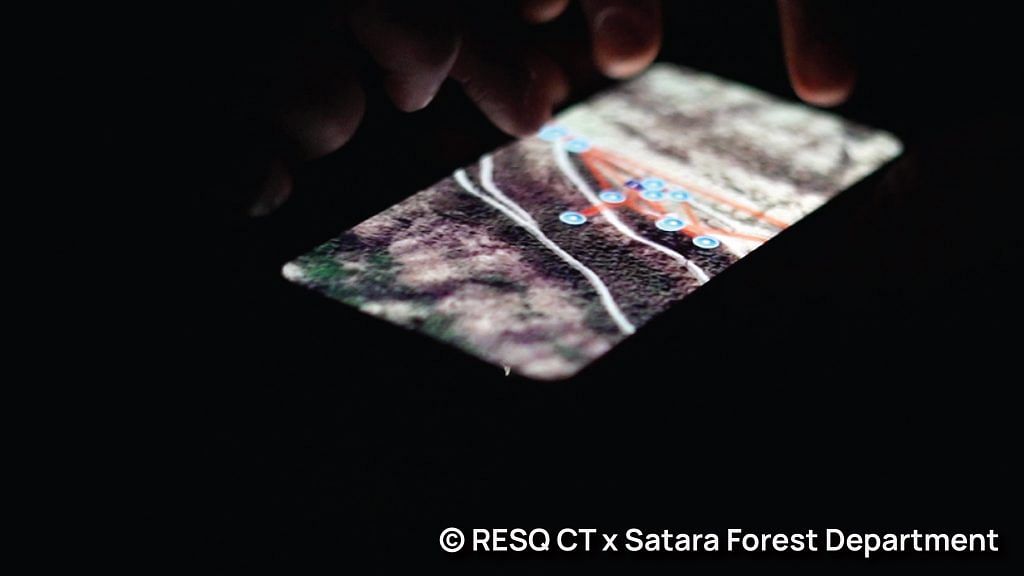
This has never been done before and we are at a nascent stage of rethinking old ideas about reintroduction. While the GPS collar should allow us to track her for one more year, there is much to learn. It is an expensive and time consuming process, but we have to try it as it is the right thing to do. Freedom has got to be a choice offered, especially in times where institutions are struggling under the pressure of intaking animals for lifetime care. The fate of wildlife is already threatened due to ever-increasing urban development, climate change and shifts in agricultural patterns in human-dominated landscapes. If we don’t push boundaries now, we will never know if these orphan animals that are generally sent into lifetime captivity, ever stood a chance back in the wild. Everyone deserves a second chance, now more than ever before.
Neha Panchamia is Founder and President, RESQ Charitable Trust. She tweets @NehaPanchamia.
(Edited by Zoya Bhatti)


